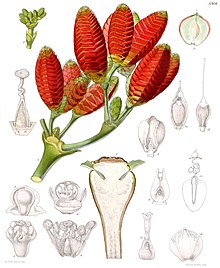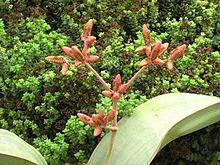Welwitschia
![]()
This article is about the plant Welwitschia. See Khorixas for the town called Welwitschia until 1989.
The Welwitschia ( ![]() ; Welwitschia mirabilis) is the only species of the genus Welwitschia in the Welwitschia family (Welwitschiaceae). It belongs to the gymnospermous order Gnetales and grows endemically in the Namib Desert of southern Africa. Due to its frequent occurrence, the Welwitschia is depicted on the coat of arms of Namibia, the coat of arms of the city of Swakopmund and the coat of arms of the Kunene region, among others. Although the plant lives for several hundred years, it has only one pair of leaves.
; Welwitschia mirabilis) is the only species of the genus Welwitschia in the Welwitschia family (Welwitschiaceae). It belongs to the gymnospermous order Gnetales and grows endemically in the Namib Desert of southern Africa. Due to its frequent occurrence, the Welwitschia is depicted on the coat of arms of Namibia, the coat of arms of the city of Swakopmund and the coat of arms of the Kunene region, among others. Although the plant lives for several hundred years, it has only one pair of leaves.
Names and botanical history
The Austrian physician and botanist Friedrich Welwitsch discovered this plant in 1859 near Cabo Negro in Angola (15-16° S). In a letter to Sir William Jackson Hooker, the director of the Royal Botanic Gardens Kew, London, dated 16 August 1860, he reported this plant for the first time. In 1862 he sent a specimen to Joseph Dalton Hooker, also at Kew, who described the plant scientifically in 1863 and named it after the discoverer. The latter, however, had recommended the name Tumboa after the native name. Hooker made the following comment about the plant: It is out of the question the most wonderful plant ever brought to this country, and one of the ugliest. ("This is without question the most wonderful plant ever brought to this country, and one of the ugliest.").
In Angola this plant species is called n'tumbo, which means "stump". The Nama call it ǃkharos or also khurub, the Damara nyanka. The Herero call them onyanga, which means "desert onion". The pith used to be eaten - raw or baked in hot ashes. In Afrikaans it is called tweeblaarkanniedood, which means "two-leaf-can't-die".

Illustration from Curtis's Botanical Magazine, 1863
Description and ecology
Appearance
The perennial plant has a short, turnip-shaped stem arising from the hypocotyl, a deep taproot, and two stem leaves replacing the cotyledons.
The trunk is woody and usually grows to a height of around 50 centimetres above ground, with a maximum of 1.50 metres. It reaches a diameter of up to one metre and has annual rings. Individual specimens have a circumference of up to 8.7 metres. The top of the trunk is a concave disc, as the terminal apex stops growing very early. Inflorescences arise near the base of the leaves. The secondary wood has tracheae, actually a typical feature of angiosperms.
Young plants are very rarely found at the natural site. Seedlings can only establish themselves after - very rare - extreme rainfall, which makes the age structure highly discontinuous. The topsoil must be completely moist for the roots of the seedlings to penetrate to greater depths. The two cotyledons can be photosynthetically active for up to 1.5 years, after which they die. Even before that, the single pair of leaves develops.
Radiocarbon dating has yielded an age of 500 to 600 years for the plants studied. For the largest specimens of the species, an age of up to 2000 years is estimated by extrapolation of these results.
Its root system spreads underground over a radius of 15 meters. In addition, the plant has a taproot. That the roots reach the groundwater horizon is probable, but not certain, since the roots are lost in a hard, calcite-cemented gravel. The roots reach down to a depth of three meters.
Sheet
The two foliage leaves can grow over 2.5 meters long, some reports speak of 6.2 meters. At the end of the leaf they die and weather, but the oldest living parts can live for 10 years. Because the hypocotyl unfolds as it grows, the leaves often rip open, feigning multiple leaves. However, individuals have been found in the Brandberg area that actually have two pairs of leaves. This occurs in about 5% of the population. The leaves grow on a basal meristem. Leaf growth averages 0.17 to 0.83 millimeters per day. Annual values vary from 40 to 409 millimeters per year depending on the location. However, there is no significant relationship between leaf growth and rainfall. Water availability in the deeper soil layers is probably more significant. The vascular bundles of the leaves may anastomose or terminate blindly in the mesophyll. This is unique among gymnosperms.
Generative characteristics
The Welwitschie is dioecious, i.e. there are female and male plants. The flowers are in cone-like inflorescences and are located in the axils of involucral scales.
The involucre of the male flowers consists of two pairs of cross-opposite bracts. The six stamens are in a whorl and are fused together at the base. Each stamen carries three fused pollen sacs. The male flowers always contain a rudimentary ovule at the apex, surrounded by an equally rudimentary pair of bractlets. This ovule produces nectar, which is about 50% sugar. The sterile female ovules and nectar production can be considered an evolutionarily failed attempt to form a bisexual flower. The pollen sacs open as in the other representatives of the Gnetopsida with an exothecium in the form of often only short slits. In Welwitschie the pollen is pressed outwards when the pollen sacs dry out, which is caused by the arrangement of wall reinforcements in the exothecium.
The male gametophyte consists of the spermatogenic cell and two other cells. The spermatogenic cell divides to form two sperm cells. Fertilization occurs via a pollen tube (siphonogamy).
The female flowers are surrounded by two pairs of fused bracts. At seed maturity the inner pair of bracts becomes hard, the outer one forms wings. Each flower contains an erect ovule. The integument is extended into a long micropyle where a fertilizing droplet, which also functions as nectar, is secreted.
The female gametophyte arises from free nuclear divisions from all four nuclei arising from meiosis and subsequent cell wall formation. It can comprise up to one thousand cells. No archegonia are formed, and the ovules are indistinguishable from the other cells of the archegonium. The gametophyte grows towards the pollen tube by forming tube-like structures.
Pollination and seed formation
Pollination is by insects, with bugs and wasps being discussed as candidates. The bug Probergrothius angolensis feeds on nectar, but pollination has not yet been clearly demonstrated. Flowering occurs from mid-summer to autumn, and the seeds mature in spring and are released by decay of the cones. The seeds are about 3.5 × 2.5 centimeters in size and have a papery wing. They are dispersed by the wind. The seeds remain germinable for several years and germinate only after heavy rains. From the approximately 10,000 to 20,000 flowers per plant and year, only about 20 to 200 germinable seeds are produced in total.

Female Welwitschia mirabilis with cone-shaped inflorescences

Flower diagram of a female flower. S = ovule

Flower diagram of a male flower. S = rudimentary ovule

Inflorescence
.jpg)
habitat in Namibia (size comparison)

Young plant

Male Welwitschia mirabilis with cone-shaped inflorescences
Search within the encyclopedia